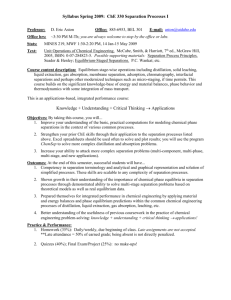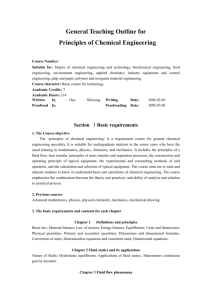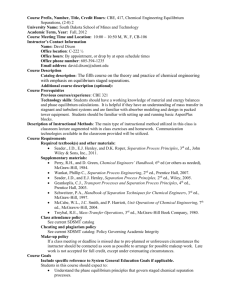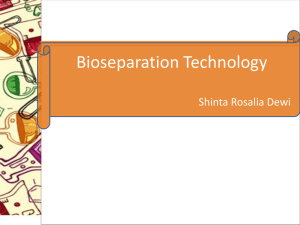Process engineering : unit operations
advertisement
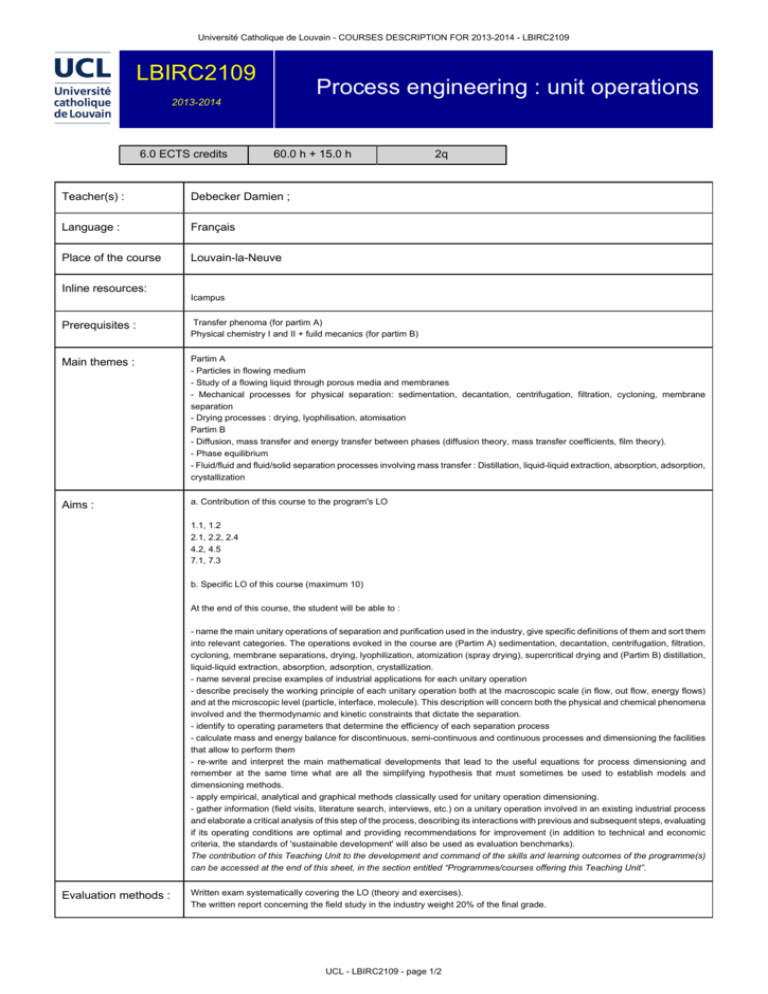
Université Catholique de Louvain - COURSES DESCRIPTION FOR 2013-2014 - LBIRC2109 LBIRC2109 Process engineering : unit operations 2013-2014 6.0 ECTS credits 60.0 h + 15.0 h Teacher(s) : Debecker Damien ; Language : Français Place of the course Louvain-la-Neuve 2q Inline resources: Icampus Prerequisites : Transfer phenoma (for partim A) Physical chemistry I and II + fuild mecanics (for partim B) Main themes : Partim A - Particles in flowing medium - Study of a flowing liquid through porous media and membranes - Mechanical processes for physical separation: sedimentation, decantation, centrifugation, filtration, cycloning, membrane separation - Drying processes : drying, lyophilisation, atomisation Partim B - Diffusion, mass transfer and energy transfer between phases (diffusion theory, mass transfer coefficients, film theory). - Phase equilibrium - Fluid/fluid and fluid/solid separation processes involving mass transfer : Distillation, liquid-liquid extraction, absorption, adsorption, crystallization Aims : a. Contribution of this course to the program's LO 1.1, 1.2 2.1, 2.2, 2.4 4.2, 4.5 7.1, 7.3 b. Specific LO of this course (maximum 10) At the end of this course, the student will be able to : - name the main unitary operations of separation and purification used in the industry, give specific definitions of them and sort them into relevant categories. The operations evoked in the course are (Partim A) sedimentation, decantation, centrifugation, filtration, cycloning, membrane separations, drying, lyophilization, atomization (spray drying), supercritical drying and (Partim B) distillation, liquid-liquid extraction, absorption, adsorption, crystallization. - name several precise examples of industrial applications for each unitary operation - describe precisely the working principle of each unitary operation both at the macroscopic scale (in flow, out flow, energy flows) and at the microscopic level (particle, interface, molecule). This description will concern both the physical and chemical phenomena involved and the thermodynamic and kinetic constraints that dictate the separation. - identify to operating parameters that determine the efficiency of each separation process - calculate mass and energy balance for discontinuous, semi-continuous and continuous processes and dimensioning the facilities that allow to perform them - re-write and interpret the main mathematical developments that lead to the useful equations for process dimensioning and remember at the same time what are all the simplifying hypothesis that must sometimes be used to establish models and dimensioning methods. - apply empirical, analytical and graphical methods classically used for unitary operation dimensioning. - gather information (field visits, literature search, interviews, etc.) on a unitary operation involved in an existing industrial process and elaborate a critical analysis of this step of the process, describing its interactions with previous and subsequent steps, evaluating if its operating conditions are optimal and providing recommendations for improvement (in addition to technical and economic criteria, the standards of 'sustainable development' will also be used as evaluation benchmarks). The contribution of this Teaching Unit to the development and command of the skills and learning outcomes of the programme(s) can be accessed at the end of this sheet, in the section entitled “Programmes/courses offering this Teaching Unit”. Evaluation methods : Written exam systematically covering the LO (theory and exercises). The written report concerning the field study in the industry weight 20% of the final grade. UCL - LBIRC2109 - page 1/2 Université Catholique de Louvain - COURSES DESCRIPTION FOR 2013-2014 - LBIRC2109 Teaching methods : Lecture with a powerpoint presentation as the main support (available via iCampus). Even if the slides are used as a support for the lectures, an important part of the course is given orally and on the blackboard (e.g. explanations, examples, mathematic developments, etc.). Experts from industry and academia are invited on a regular basis to illustrate some of the chapters of the course in an applied perspective. Quantitative exercises of dimensioning with a tutor. Student visit a pilot installation for separation, take experimental data points and use them to solve exercises. Scientific articles are recommended for reading as a complement to the course. Students are instructed to visit a company of their choice and to study a unitary operation involved in the production process. A short report is written. Content : Introduction Objectives ' instructions ' process engineering and unitary operations : definitions ' main working principles of unitary operations for separation ' the different operating modes ' context ' classification of unitary operations Partim A Separation processes based on mechanical action Particles in fluids (Context ' Description of a divided solid ' the isolated particle ' a bunch of particles ' Characterization of a bed of particles) / Sedimentation and Centrifugation (Definitions ' Interactions between the fluid and one particle ' flow regimes ' sedimentation rate) / Flows through porous media (the Darcy law ' the Kozeny Carman model ' turbulent flow ' the Ergun relation) / Filtration (Context ' Support filtration ' Coupling the variables ' Humidity ratio ' Cake dimensions ' Resistance to the flow ' Operating modes ' Filtration technologies) / Membrane separation (Description ' Applications ' Diffusion principles ' Materials ' Mass transfer ' Dialysis ' Electrodialysis ' Inverted osmosis ' Gas permeation ' Pervaporation ' Membranes in bioprocesses Drying processes Motivation / Definitions and concepts (wet solid ' gaz-liquid-solid equilibrium ' wetting enthalpy ' sorption isotherms ' equilibrium diagrams) / Techniques et set-up (classification ' machines often used in the industry ' drying by ebullition ' drying by flow ' lyophilisation ' drying of bio-products) / Theoretical principles of drying (drying kinetics ' hygrometry ' wet air diagram ' case study: the drying of cereals in a grain silo) / Alternative mode for providing energy / supercritical drying Partim B Fluid/fluid separation and fluid/solid separation involving mass transfer Liquid-gaz equilibrium of binary systems (Reminders ' the Raoult law ' non ideal mixtures ' Influence of pressure ' Systems with more than two species) / Distillation (Basic working principles of distillation' Simple discontinuous distillation(batch)' Continuous distillation(flash distillation)' Fractionated distillation: working principle, Plate colonne, the method of Sorel, the method of Lewis, the method of Mc Cabe & mp; Thiele, Study of the column with the equilibrium diagram, vapor injection, the method of Ponchon& mp; Savarit, Study of the columns with the enthalpy diagram, Rectification of azeotropic mixtures, Rectification mixtures with more than two species, Column efficiency) / Liquid-liquid extraction (Reminders on ternary diagrams ' Extraction in one contact stage ' Extraction with multiple contact stages ' Countercurrent extraction with separate contact stages ' Countercurrent extraction with uninterrupted contact ' Countercurrent extraction with reflux) / Gas absorption by liquids (Equilibrium condition ' Graphical representation ' Number theoretical stages ' Continuous transfer ' Absorption of several species ' Absorption with chemical reaction) / Adsorption (Adsorption on a solid ' Adsorption equilibrium for a pure gas 'Adsorption equilibrium for a gaseous binary mixture ' Adsorption equilibrium for a liquid binary mixture - Adsorption separated stages ' Adsorption in fixed bed) / Crystallization (Definitions ' the crystalline state ' Solubility curves ' Sursaturation curves ' Basic principles of crystallization in solution ' Crystallization processes ' Purity and morphology of crystals Bibliography : Cycle and year of No mandatory book teaching support Slides used during the lecture are provided on iCampus and should be printed before each lecture. Recommended (optionnal) books available at the BST library: 'Introduction au génie des procédés' D. Ronze (Editions Tec et Doc, 2008), ISBN : 978-2-7430-1066-9 'Separation process principles' E.J. Henley, J.D. Seader, D.K. Roper (Wiley, 2011) ISBN : 978-0-470-64611-3 'Le pétrole - Rafinage et genie chimique I' P. Wuithier (Editions Technip, 1972) ISBN : 2-7108-0198-1 'Procédés de séparation' J.P. Wauquier ((Editions Technip, 1998) ISBN : 2-7108-0671-1 > Master [120] in Chemistry and Bio-industries > Master [120] in Environmental Bioengineering study : Faculty or entity in AGRO charge: UCL - LBIRC2109 - page 2/2
